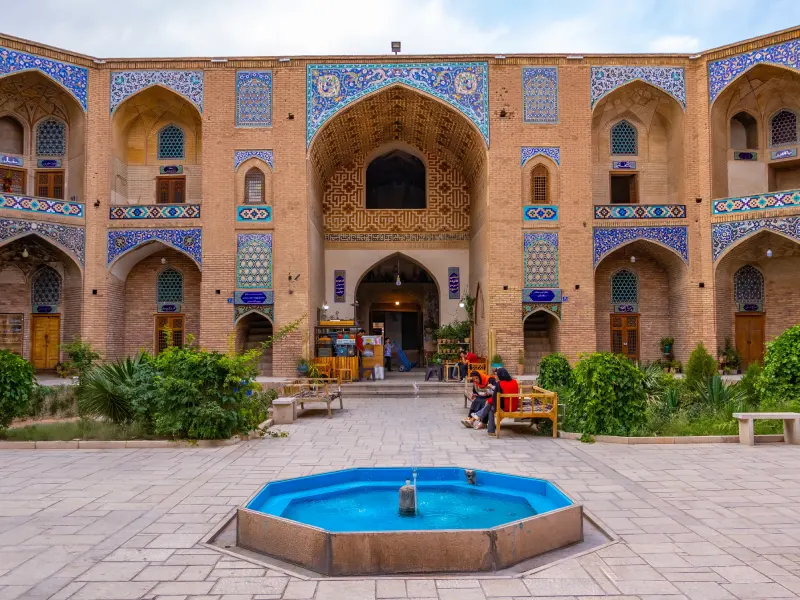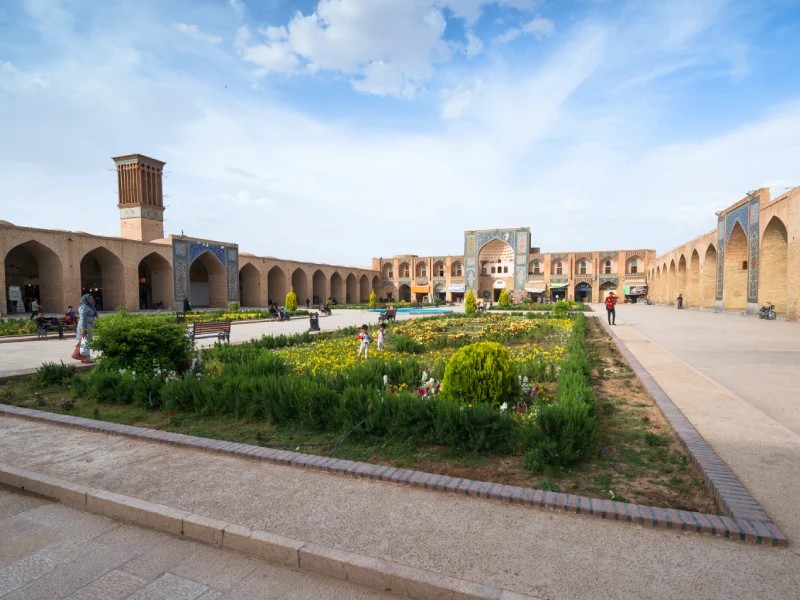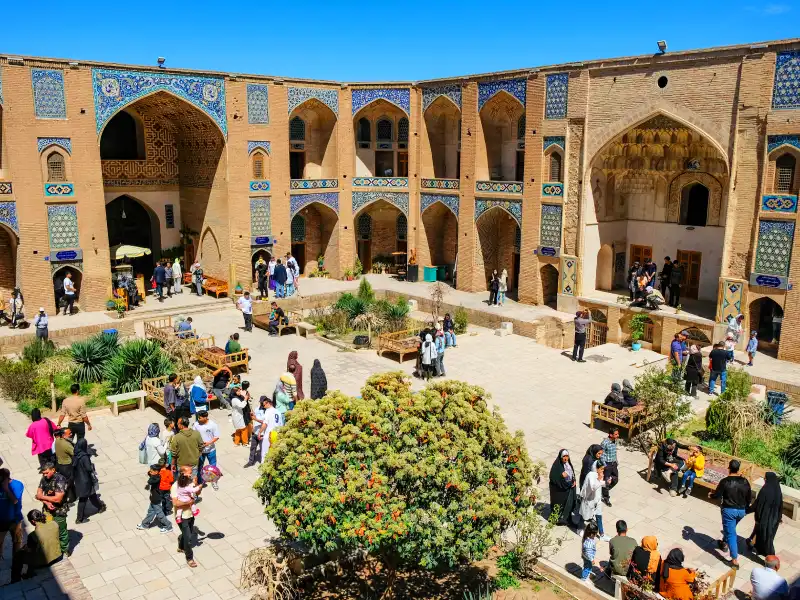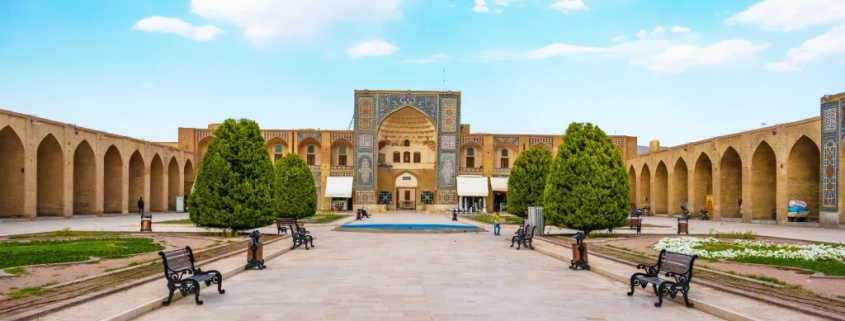Ganjali Khan Complex, Kerman (Mosque, Bathhouse, Bazaar)
The Ganjali Khan Complex is a unique historical site located in Kerman, Iran. This complex unveils a blend of architectural marvels from the Safavid period and is an emblem of Persian artistry and craftsmanship. The complex consists of various sections, including a square, bathhouse, mosque, bazaar, and museum, all of which are designed with intricate details and precision. The site reflects the vision of Ganjali Khan, the governor of Kerman during Shah Abbas I’s reign, who sought to create a space that served both social and cultural purposes for the people. Let’s learn more about this complex, one of the top things to do in Kerman.
About Ganjali Khan Complex
Today, the Ganjali Khan Complex displays the rich cultural heritage of Iran and provides insight into the lifestyle and social structures of the Safavid era.
This complex is not only a destination for tourists but also a focal point for historians, architects, and artists who admire its unique blend of functionality and beauty. Visiting this complex allows one to step back in time and experience the grandeur of Persian architecture.
Beyond its aesthetic appeal, the Ganjali Khan Complex is known for its strategic layout. Each section serves a specific purpose and reflects the ingenuity of its creators in designing a space that balances both public utility and spiritual needs.
Ganjali Khan Complex History
The Ganjali Khan Complex was constructed in the early 17th century, during the Safavid Empire, under the direction of Ganjali Khan, who was appointed as the governor of Kerman. This period is known for significant architectural and cultural advancements in Iran, with the Safavid rulers keen on embellishing their cities with public buildings that reflected their dynasty’s power and sophistication.
Ganjali Khan’s ambition was to establish a complex that would meet the diverse needs of Kerman’s people, providing them with places for trade, worship, relaxation, and learning.

Ganjali Khan’s vision was realized with the help of renowned architects and craftsmen of the time, who meticulously planned and executed the construction. Over the years, the complex has witnessed various renovations to preserve its original structure and continue its legacy as a historical and cultural landmark.
This historical complex has remained relatively well-preserved, thanks to restoration efforts initiated over the centuries. Today, it is celebrated as one of the most significant architectural achievements of the Safavid period and continues to be a source of pride for the people of Kerman.
Ganjali Khan Complex Architecture
The architecture of the Ganjali Khan Complex is a brilliant example of Safavid-era design, characterized by elaborate tile work, stucco, and Islamic geometrical patterns. The use of vibrant colors and intricate mosaics in the complex’s decoration is typical of Persian architecture, lending the site a distinct charm and historical allure.
One of the most remarkable features of the Ganjali Khan Complex is its cohesive design, where each part complements the other. The central square, for instance, serves as a gathering space and is surrounded by other facilities that fulfill various community functions. The meticulous symmetry and artistic elements found in the mosque, bathhouse, and bazaar demonstrate the expertise of Safavid architects in creating spaces that are both functional and beautiful.
Natural light and ventilation are also skillfully incorporated into the architecture of the Ganjali Khan Complex. From the dome of the mosque to the openings in the bathhouse, every architectural choice reflects a deep understanding of the environment and the needs of the community.
Ganjali Khan Square
The Ganjali Khan Square is the heart of the complex and serves as a focal point for visitors and locals alike. This square was designed as a bustling marketplace where people could gather, trade goods, and socialize. Surrounded by arcades and shops, the square maintains its lively ambiance, allowing visitors to imagine what life might have been like in Safavid-era Iran.
The design of the square follows a traditional Persian layout, with a rectangular shape and symmetrical arrangements. This open space was essential for the community, providing a place for commerce, announcements, and social interaction. Its strategic location within the complex made it easily accessible to visitors entering from different points.

Visitors to Ganjali Khan Square today will find it a beautiful and serene location that invites reflection and admiration of its historical significance. The square is particularly striking at sunset when the colors of the tiles and architecture come to life under the golden light.
Ganjali Khan Mosque
The Ganjali Khan Mosque, though relatively small compared to other Persian mosques, holds immense cultural and architectural significance. Built as part of the complex, the mosque was intended to serve as a place of worship and spiritual refuge for the people of Kerman. Its design is marked by elegant arches, intricate tile work, and a modest yet beautiful dome that symbolizes the Islamic architectural style of the Safavid era.
Inside, visitors can observe the impressive calligraphy and geometric patterns that adorn the walls and ceilings. These decorations not only serve an aesthetic purpose but also embody spiritual symbolism. The layout of the mosque is intended to create a sense of tranquility, allowing worshippers to connect with their faith in a peaceful environment.
Despite its size, the mosque is an essential part of the Ganjali Khan Complex, symbolizing the importance of spirituality in daily life during the Safavid period. Its preservation over centuries shows the care and respect the people of Kerman have for their historical monuments.
Ganjali Khan Bathhouse
The Ganjali Khan Bathhouse is one of the most fascinating sections of the complex, offering insight into the bathing culture of the time. Known for its stunning architecture and decorative elements, the bathhouse features murals, tiles, and carvings that depict scenes from Persian mythology and everyday life.
The bathhouse was designed with a series of rooms for various purposes, including a dressing area, a hot bath section, and a cold-water area.
This bathhouse is an excellent example of Persian public bath architecture, with carefully designed heating systems and ventilation that allowed for comfortable bathing.
Today, the bathhouse has been converted into a museum, where visitors can explore its historical significance and appreciate its artistry. The ambiance of the bathhouse transports visitors back in time, offering them a glimpse into the daily lives and social customs of Safavid Iran.
Ganjali Khan Bazaar
The Ganjali Khan Bazaar is a vibrant marketplace that retains the charm and energy of a traditional Persian bazaar. Located within the complex, this bazaar once served as a commercial hub where traders could sell their goods, ranging from spices and textiles to handicrafts and jewelry.

The architecture of the bazaar is designed to be both practical and aesthetically pleasing, with high ceilings and spacious corridors that provide ample room for trade.
The bazaar’s layout encourages interaction among visitors and vendors, reflecting the social nature of Persian marketplaces. The intricate tile work and decorative elements throughout the bazaar make it a visually captivating experience for anyone walking through its alleys. Visiting the Ganjali Khan Bazaar today allows tourists to experience the essence of traditional Iranian commerce and culture.
Ganjali Khan Museum
The Ganjali Khan Museum, housed within the bathhouse, showcases a remarkable collection of artifacts from the Safavid period. The museum displays items such as ancient coins, pottery, textiles, and traditional costumes that provide insight into the daily lives of the people who once frequented the complex. This museum serves as a time capsule, preserving the cultural and historical heritage of Kerman.
In addition to historical artifacts, the museum also offers information on the architectural techniques and artistic styles used in the complex’s construction. Visitors can learn about the different stages of development of the Ganjali Khan Complex and gain a deeper understanding of Persian art and architecture.
The museum is a valuable resource for anyone interested in Persian history, art, or architecture, as it offers a well-rounded experience of Kerman’s past.
Last Words
The Ganjali Khan Complex is a priceless gem in Iran’s rich tapestry of historical landmarks. From its beautiful mosque and intricate bathhouse to its lively bazaar and informative museum, every part of the complex tells a story of cultural pride, architectural mastery, and community spirit. Visiting this complex is like stepping into the pages of history, allowing one to experience the beauty and sophistication of Safavid-era Iran firsthand. If you’re looking for more historical sites to visit in Kerman, you can check out Bam Citadel and Rayen Castle, which will take you back to the ancient times of Great Persia.
Are you planning to travel to Iran and looking for an Iran resort? Consider Matinabad Eco-resort.





Leave a Reply
Want to join the discussion?Feel free to contribute!